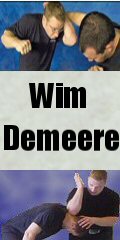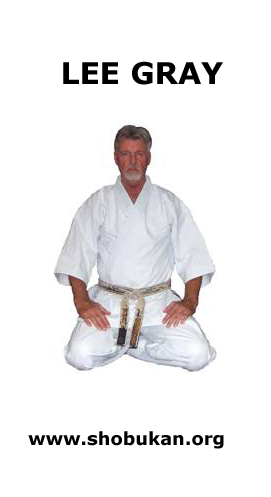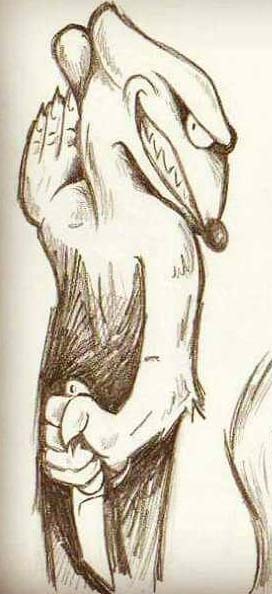|
A nation that will insist on drawing a broad line of demarcation
between the fighting man and the thinking man
will have its fighting done by fools and its
thinking done by cowards.
Sir William Francis Butler
Martial Training
On this page:
Adrenal decay |
Aliveness and Other Nonsense* |
Angles |
Application (bunkai) |
Basics vs. Fundamentals |
Distance |
Effective Movement |
Evaluating a Martial Art |
Finding a Technique's Optimum Range |
Four Focuses of Martial Arts |
Know Your Tools |
McDojo |
Message to School Owners/Instructors |
Muscle |
Mushy Movement |
Power |
Receiving Force |
Stance |
Technique |
Training Goals |
Unnecessary Movement |
What If Monkeys
This martial arts sub-hub is collection of tips, ideas and concepts for
training. Issues that by sitting down and considering you can -- and
will -- greatly enhance the effectiveness of what you are doing. This no
matter what level you are at.
Our reasoning for this is twofold: First, is so that a student can use
these ideas to learn the art/style/system/training that he/she is involved
in. These are explanations of issues, challenges and concepts that are often
confusing and/or poorly explained. This is not a condemnation of your
instructor, what it is based on is that often an instructor does moves so
instinctively that it can be difficult to articulate them. By explaining
these concepts the student can learn and faster, easier and with greater
comprehension.
Our second reason, is to provide a set of explanations that
instructors can use to communicate to the students ideas that are
often difficult for beginners to grasp. Elements that the instructor may
understand instinctively, but often has a hard time communicating --
for the very reason that they are so ingrained that they are
unconsciously done. These elements, while they are instinctive to
the instructor, are not apparent to the student. And without
specific articulation and explanation, a majority of your students will
never develop these attributes. (And we suspect that the frustration
of trying to make partial techniques work plays a significant role in
student drop out).
Both purposes help students learn faster and focus on important aspects
that must be present for them to effectively apply what they are learning.
What we wish to do with this section is address elements relating to
training, understanding and the application of your art/system...that's
complex enough without muddying the water with all kinds of other issues..
Adrenal Decay
Get a cup of coffee before you go to this
page. Most of what people 'know' about adrenal decay is advertising. I take
a chainsaw to the misconceptions, misunderstandings, mythology -- and most
of all -- marketing that surrounds your martial arts training and
adrenal decay.
Aliveness and Other Nonsense
There are some bad training paradigms that have crept into the martial
arts world. Unfortunately, ill informed instructors, commercialized
schools and watered down martial art systems have given marketers of
these 'training fads' a target rich environment to draw people from
traditional martial arts. See how many of these' what
you think you know is advertising' that you've fallen for.
Angles
Understanding slight directional changes in how you are
applying force has a major effect on how much work you have to do and
how effective you are. Learning how to correctly use
angles is a critical step in improving how effective you are -- and
if your opponent can keep on resisting you.
Application (Bunkai)
The sad truth is that most of what is
explained as the uses of moves from forms/katas simply does not
work. That does not, however, that the move cannot work.
There are several ways that thing can -- and do -- go wrong. We provide a
checklist of ideas you can use to analyze why a move isn't working
the way you were told it does.
Basics vs. Fundamentals
Many people do not understand that
-- although very close in meaning -- there is a difference between these
two terms. A difference, that if you do not consciously address,
critical components will be lost from instruction. Unfortunately, most
people neither know or address these differences and by doing so
rob themselves and their students of effectiveness.
Distance
Where you are standing has major influence on whether
at technique is going to work or not. Notice we didn't say 'whether or
not you can do the technique' we said whether it is going to work or
not. Unfortunately many people try to make a technique work from the
wrong distance, in doing so they rob themselves of power and
effectiveness. This introduction to the importance of
distance (range) will help you understand why so often things aren't
working.
Return to top
Effective Movement
The importance of effective movement cannot be understated, it is a
fundamental. Unfortunately, it is a fundamental that's significance has
been lost to many people -- including most instructors. This page not
only addresses the standards of
effective movement, but the tactical and strategic implications and
applications.
Evaluating a Martial Art
How can you tell something is
'good' if you don't know what you are looking at ... or what you are
looking for? There are key points to look for when evaluating a
martial art's effectiveness.
Finding a Techniques Optimum Range
Now that you know distance/range is so important for power delivery how do you find it for
a particular technique? Here is a simple series of experiments you can
do to find a technique's
optimum range.
"The Four Focuses of the Martial Arts"
While there are many reasons to study the martial arts, there are basically four main
focuses. Each focus is valid and worthwhile. Each is extremely
specialized and tailored to achieve a certain goal. It is by
recognizing the
four different focuses that allows you to select the school, style
and focus that best suits your needs.
Know Your Tools
One of the most ignorant things anyone can say
is "I know that already." This simple statement is why the counter --
common among survival trainers -- of "What you think you know will kill
you" was developed. Before you can apply your tools in different
situations you have to have thought about how to do it. Although largely
philosophical, the points made on this page will forever change how you
look at training.
Message To MA School Owners/Instructors
Fads, fashions and trends affect what is taught as martial arts. However, we suspect there
is something looming on the horizon that will not just have an effect
on your teaching, but that if you don't adapt to it, it will crush your
business. The
Open Message to MA School Owners/Instructors is to give you a
chance to prepare for what we see is coming as the future of martial
arts.
McDojo
There are many reasons a school can turn into a McDojo.
The biggest problem is the poor training that they provide can burn you
out on the martial arts. However, if you leave a belt factory for better
training another problem you'll face a different problem from learning a
watered down system. That is that McDojo training makes it difficult to
relearn a movement -- but in an effective way The different ways of
moving will conflict with each other. Instead of having to relearn
everything, learn how to spot a
McDojo.
Muscle
Unfortunately, many martial artists when they are in the
wrong range and moving poorly try to compensate by using muscle. If you're
big and strong enough it might even seem like you are making a flawed
technique work ... you're not, you&'re using muscle. Many problems arise from
this, not the least of which is a smaller, weaker person cannot make a bad
technique work this way. We take a look a this and the other problems that
arise from using
muscle to try to make your
martial arts work.
Mushy Movement
The challenge is not how to generate
more force, the challenge is how not to waste the force
you are already generating. Unfortunately, many people -- by not
understanding the significance of their system's movement -- fail at
this challenge. Worse, many martial artists -- in trying to solve this
problem, by cross training -- end up creating more problems. Over and
above the tendency to incorrectly move within their own system, quite
often, cross trained individuals end up attempting to execute moves from
other systems based on their original style's body mechanics. This
results in additional loss of power. This page addresses the
fundamentals of power generation through
body movement.
Power
Many people mistakenly believe that effective
fighting is about how much power you generate. We disagree. We feel that
being able to effectively deliver power into you opponent is more about what
you don't do to lose power. And while the list long of what people don't
know about
power generation, it is even longer with how they lose power.
Receiving Force
Although written for law enforcement
officers, this page may prove useful to martial artists in its explanation
on how to take the force your opponent is generating without losing the
ability to
operate tactically.
Stance
Odds are you weren't taught how to use stances properly. Here are
concepts that your instructor more than likely didn't explain to you
about the
Stances you use.
Technique
It's time to take a long hard look at what you think a technique is.
What does a technique do, what doesn't it do? And what do you need to be
focusing on when you teach a
technique?
Training Goals
What are you expecting out of your self-defense training? Before you
think you are getting effective self-defense training, you had better
understand the different training goals and what is involved in
different
types of training.
Unnecessary Movement
There is a BIG (did we mention big?) difference between what generates
power and what you think
generates power. Unfortunately, what you think makes for a powerful move
plays way too big of a part in how
you move. Many people, in attempting to add in more power actually are
robbing themselves of power by putting in extra and
unnecessary movement.
What If Monkeys
It seems that no matter what seminar
you go to there is always someone asking "What if it doesn't work?"
Although this page is important for students to read, this page is by
and large written for martial arts/ self-defense instructors, giving
them advice on how to handle
WIMs
Return to top

|








